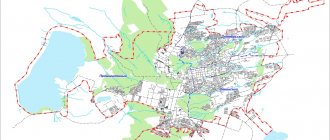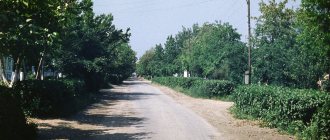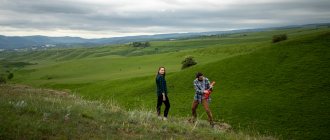Description and characteristics of the Taganka variety
The remontant late-ripening Taganka raspberry was obtained by the breeder of the Moscow All-Russian Breeding and Technological Institute of Horticulture and Nursery Growing V.V. Kichina. The characteristic “remontant” means that raspberries can bear fruit not only on last year’s stems, but also on the current year’s shoots. True, according to reviews of some lovers, Taganka is more likely a “semi-remontant” variety. The fact is that although the crop is planted on annual shoots, it is very late - in a cold climate it may not ripen.
Taganka bushes grow large, about 2 m tall
Taganka bushes are large and spreading, up to 2 m tall. Each of them produces 7–9 rather thick shoots of a brown or brownish hue. Also, up to 4–5 root shoots grow during the season. The branches are densely covered with large dark green leaves. A distinctive feature of the Taganka is its numerous, but small and soft purple spines. The berries are tied on fruit branches of 20–30 pieces (which is why the branches sometimes break off).
The berries are so large that fruit branches sometimes break off under their weight.
Taganka fruits are very large (6–8 g, maximum up to 17 g), have the shape of a cone with a rounded top and are colored a rich scarlet color. The dark red juicy pulp is characterized by a sweet taste and is covered with a thin but rather dense skin. The berries have a strong aroma characteristic of raspberries.
Ripe berries can be easily removed from the stalk. The berry comes off dry.
About remontant raspberries - video
Seaside Park
The quality of small objects on the ultra-wide-angle camera leaves much to be desired.
But it will do for Instagram. The most beautiful and well-kept park. A large-scale reconstruction was recently completed, during which the Soviet asphalt was replaced with modern tiles, the stairs were updated, underground wiring was installed and much more.
Now it is a nice place to walk around. In the evening, especially on weekends, there are a lot of people. Perhaps this is the only negative, but not for everyone.
One interesting thing to note is an alley with anchors that were raised from the bottom of the Taganrog Bay.
If you go lower, you will find yourself on Primorsky Beach.
Tourists very rarely come to this beach; it is mainly popular among residents of the area.
For me, this is the worst beach in the city. There are no sun loungers, bars or playgrounds. The shore is terrible: a lot of rocks and breakwaters.
Therefore, it is better to turn around and take a walk through the renovated park.
One of the park's exits leads to the abandoned building of the Taganrog Automobile Plant.
Until 2014, Hyundai, Vortex and Tagaz cars were assembled here. On topic: I've been using iPhone 11 for six months. I found all the shortcomings
In 2014, the plant was declared bankrupt. For six years, the vast territory of TagAZ has been empty, all the buildings have been destroyed, the remains of the equipment are being sold for metal.
During Soviet times, this plant produced combine harvesters.
Advantages and disadvantages of the variety
Advantages:
- good winter hardiness of the bush in general and the root system in particular (withstands temperatures down to -20°);
- high yields (up to 5 kg from 1 bush);
- soft, non-thorny thorns;
- large size and good presentation of berries;
- resistance to major diseases and pests.
Flaws:
- poor drought resistance, deterioration in berry quality during prolonged drought;
- The berries are poorly stored and quickly begin to “leak.”
Extreme weather events in Taganrog
Extreme weather events rarely occur in Taganrog. But in recent years, the number of various anomalies around the world has increased sharply. Taganrog was no exception. 2014 turned out to be unfavorable here:
- On January 29, heavy snowfall hit the city. Public transport was paralyzed for several days. It was also impossible to travel on intercity highways. One of the buses traveling along the Odessa-Krasnodar route was completely stuck in snowdrifts. The rescue operation lasted for 3 days. It was possible to completely eliminate the consequences of the emergency only by February 7th.
- The next disaster struck the city about half a year later. On September 24, 2014, a strong hurricane was observed in Taganrog. The speed of air flows then amounted to 32 m/s. Due to the wind surge of sea water, its level rose by more than 3 meters, which is the highest level in the history of observations. As a result, low-lying areas were flooded. The houses located there were damaged. Electricity was cut off everywhere due to downed power lines. The total damage from the disaster amounted to 230 million rubles.
Landing Features
Landing dates
It is necessary to plant raspberry bushes before the sap begins to flow. You can plant in both autumn and spring, but spring planting is considered more desirable, as it gives the plant a better chance to take root. If your site is located in warm southern regions, you can safely plant in the fall - the bush will have time to take root well before frost.
Selection of planting material
If possible, purchase seedlings from state nurseries - this way you will reduce the risk of getting infected plants. Choose seedlings carefully. The root system must be developed, the roots must not have dry or rotten areas, the stems must be intact and healthy. Keep in mind that outwardly Taganka raspberry seedlings do not look powerful - they are quite small and thin. This does not at all prevent them from taking root well.
If raspberries are already growing on your or a neighboring plot, you can get seedlings by dividing the bush. To do this, select healthy shoots and remove them during pruning using a fork, trying to capture the maximum number of roots.
Raspberry root suckers can be excellent planting material
Seeds of remontant raspberries in 2/3 of cases retain the properties of the mother plant, so if desired, raspberries can be propagated by seeds. To do this, ripe berries are placed in a bag made of nylon fabric, the pulp is crushed and washed with water. Then the seeds are dried directly in the bag. Such seed can be stored in the refrigerator (+1...+3 degrees) for up to several years. Sow seeds to a depth of 5 cm.
Selecting a location
Raspberries can grow in almost any soil, provided there is good nutrition and drainage. Plants do not tolerate stagnation of moisture - the root system quickly rots. At the same time, raspberries also do not tolerate drought well, so the soil should always be moderately moist.
Warm, well-lit areas with sun are preferred for planting. In the shade, the yield drops sharply and the taste of the berries deteriorates. A little partial shade for raspberries is quite acceptable.
An openwork fence significantly weakens the wind pressure
It is important to provide protection from the wind, since raspberry stems are easily damaged, and the activity of pollinating insects is also disrupted. Strips of land along fences or buildings work well in this regard.
Soil preparation
The soil should be prepared in advance. The area planned for planting must be thoroughly cleared of weeds and fallen leaves and dug up. You can add 2–2.5 buckets of compost or rotted manure, as well as 150 g of wood ash per 1 m2.
To plant raspberries, it is best to make a groove and fill it with fertilizers
The best trenches for planting raspberries are those with a width and depth of 40–50 cm. The length should be such that all seedlings fit at intervals of 1–1.2 m. A distance of 2 m should be maintained between rows. Fill the trench to 1/3 of the depth a nutrient mixture of 10–12 kg of compost, 0.2 kg of superphosphate and 0.12 kg of potassium salts per square meter. Place a thin layer of soil on top of the fertilizer.
Landing sequence
- Inspect the seedlings again, cut off any broken or dry roots.
- Dip the roots into the clay mash.
- Place the seedlings in the trench so that the root collar is no lower than the soil surface. Spread out the roots.
- Cover the root system with soil and compact it carefully.
- Cut the stems to a growth bud at a level of 20–25 cm from the ground.
- Water the plants (7–8 liters of water per bush) and mulch the soil surface with humus.
Planting raspberries on video
Plant care
Watering
Like other raspberry varieties, Taganka does not like stagnant moisture. However, it also does not tolerate drought well; a prolonged lack of water causes a decrease in the quality of the berries and a decrease in yield.
Therefore, raspberries need to be watered regularly, but moderately. Water is especially necessary during the formation of ovaries and ripening of the crop. Watering should be done once every 14–15 days, in the morning or evening. You can use sprinkler irrigation or apply water to irrigation furrows. The watering rate is 2–2.5 buckets per 1 m of row.
Trimming
Taganka raspberries can be grown as an annual or biennial crop. In the first case, after picking the berries, you should cut off all the stems at ground level so that there are no stumps left. In cold climates, it is better to grow it as a biennial, with only last year's stems cut off in the fall.
In the spring, you may need sanitary pruning - removing dried and damaged areas of the stems to a healthy bud.
If the bushes are not too thick, you don’t need to thin out the plantings. All shoots appearing outside the row should be eliminated.
Pruning remontant raspberries on video
Tying up
To make caring for bushes easier, it is recommended to tie them to supports. Common supports for raspberries are trellises: single, double, Scandinavian. The simplest trellis is a single one, which is a series of 2.5-meter posts on which support wire is stretched at different heights.
A double trellis is installed in the same way as a single one, but the top row of wire is pulled lower, so the height of the posts can be less (usually 2 m).
A single trellis is the simplest support for raspberries.
To each extreme and intermediate post at the level of 85–90 cm and 140–150 cm, you need to attach 2 crossbars 50 cm long and 5 cm wide. Pull parallel wires on these crossbars at intervals of 60 cm. Between the main guides, cross bars are pulled every 60 cm wires - they are needed to support the shoots. With such a system, it is possible to form a larger number of shoots and accordingly increase the yield. But picking berries from the stems inside the trellis is inconvenient, and ventilation conditions worsen, which creates conditions for the spread of fungal diseases. If the plantings are not protected from the wind, the stems may break on the wire, so they must be tied to it.
Double trellis allows for a larger harvest
Top dressing
Starting from the 2nd year after planting, raspberry bushes need to be fed annually in the fall with humus (5–6 buckets) and potassium sulfate (30–35 g). In the spring, nitrogen fertilizers are applied - ammonium nitrate or ammonium sulfate (15 g). Superphosphate (60 g) should be added once every three years. All doses are indicated per 1 m2. Mineral fertilizers are scattered over the surface of the soil and lightly mixed with a pitchfork, and then watered.
One of the most important fertilizers is superphosphate
During flowering (June), it is useful to mulch the soil around the bushes with a layer of peat or rotted horse manure. Also in summer it is recommended to apply an infusion prepared from 1 shovel of fresh manure per 10 liters of water.
Soil care
The soil in the raspberry garden should be loose and free of weeds. To do this, it is recommended to carry out regular loosening after watering (when the soil surface dries slightly). Raspberry roots are close to the surface (depth 15–20 cm), so you need to cultivate the soil to a shallow depth.
Preparing for winter
If you have cut all the stems, then no special preparation is required; you just need to mulch the rows with peat to improve the wintering conditions of the root system.
If you left annual shoots, they need to be tied together, bent to the ground and covered with some kind of insulating material (reeds, spruce branches, nutrasil).
Pests and diseases of raspberries
Taganka is quite resistant to the usual range of pests and diseases. Still, not a single plant has 100% resistance, and some diseases and harmful insects need to be feared.
Table: raspberry pests and their control
| Name in the editor | Description of the lesion | Control measures |
| Raspberry beetle | A small, “hairy” yellowish-brown beetle attacks buds, flowers and leaves. The larvae damage the berries by making tunnels in them. As a result, the berries become deformed, become small and often rot. | Destroy beetles manually. Treat with Fitosporin or Karbofos. Repeat treatments at intervals of 2 weeks until the pests disappear. |
| Spider mite | It sucks the juice from the leaves and entangles them in a web. The affected leaves curl and dry out, and if the infection is severe, the entire bush dies. |
|
| Raspberry shoot aphid | Colonies of insects settle on the stems, sucking the juices from the leaves and tops of the shoots. The leaves begin to curl, dry out and fall off. |
|
Raspberry pests in the photo
The beetle damages buds and flowers, and its larva damages berries
Aphids not only suck juices from the plant, but also carry diseases, such as infectious chlorosis
Infectious chlorosis may be a consequence of an aphid infestation. The mite sucks nutrients from the leaves and weaves them into webs.
Table: raspberry diseases and methods of combating them
| Name of the disease | Nature of the disease | Processing methods | |
| Purple spot | The leaves, young shoots and buds are covered with a violet-brown hue that does not have clear boundaries. The spots grow and cover the shoots in a ring. The bark peels off and falls off. Defeat can occur during the entire growing season. |
| |
| Anthracnose | Small gray spots with a purple outline appear on leaves, buds and shoots, as well as fruit branches and berries. They steadily spread and the plant dries out. |
| |
| Powdery mildew | In the first 4–5 weeks of summer, a white powdery coating appears on the leaves (both below and above). Growth points can also be affected, which become deformed and growth stops. Diseased leaves dry out, the volume of the harvest and the quality of the berries decreases. |
| |
Raspberry diseases in the photo
Purple spot often affects plants in late summer Powdery mildew often appears in hot and humid weather Anthracnose affects raspberry leaves and shoots
Photos of Taganrog
Taganrog: Photos Weather Map Hotels
Countries of the worldRussiaCitiesTaganrog
1
This collection contains 70 photographs of Taganrog, its views, houses and attractions, which were taken by local residents, tourists and photographers. All photos of Russian cities and attractions are presented in high quality, we hope that this will help you get to know them better.
VKontakte facebook twitter
Photos of other Russian cities Photos of Moscow Photos of St. Petersburg Photos of Sochi Photos of Tula Photos of Yaroslavl Photos of Vladimir Photos of Voronezh Photos of Yekaterinburg Photos of Ryazan Photos of Tver Photos of Sevastopol Photos of Dmitrov Photos of Rostov the Great Photos of Ivanovo Photos of Orel Photos of Nakhodka Photos of Belgorod Photos of Bryansk Photos of Volgograd Photos of Kazan Photos of Kaluga Photos Krasnodar Photo Lipetsk Photo Nizhny Novgorod Photo Penza Photo Samara Photo Saratov Photo Smolensk Photo Tambov Photo Chelyabinsk Photo Anapa Photo Kolomna Photo Yuzhno-Sakhalinsk Photo Vladivostok Photo Grozny Photo Izhevsk Photo Kostroma Photo Kursk Photo Omsk Photo Perm Photo Rostov-on-Don Photo Ufa Photo Cheboksary Photo Chita Photo Kerch Photo Pushkin Photo Sergiev Posad Photo Murom Photo Yeisk Photo Abakan Photo Saransk Photo Dolgoprudny Photo Balashikha Photo Irkutsk Photo Kirov Photo Novosibirsk Photo Orenburg Photo Podolsk Photo Ulyanovsk Photo Essentuki Photo Magadan Photo Alushta Photo Mytishchi Photo Krasnoyarsk Photo Togliatti Photo Khabarovsk Photo Myshkin Photo Kaliningrad Photo Rybinsk Photo Stavropol Photo Suzdal Photo Tomsk Photo Tyumen Photo Pyatigorsk Photo Ukhta Photo Astrakhan Photo Blagoveshchensk Photo Murmansk Photo Novorossiysk Photo Pskov Photo Ulan-Ude Photo Gelendzhik Photo Uglich Photo Pitkyaranta Photo Arkhangelsk Photo Barnaul Photo Vologda Photo Yoshkar-Ola Photo Kemerovo Photo Kurgan Photo Magnitogorsk Photo Nalchik Photo Surgut Photo Taganrog Photo Yakutsk Photo Simferopol Photo Balakovo Photo Svetlogorsk Photo Ordzhonikidze Photo Zheleznovodsk Photo Engels Photo Komsomolsk-on-Amur Photo Armavir Photo Vladikavkaz Photo Makhachkala Photo Norilsk Photo Tuapse Photo Yalta Photo Torzhok Photo Ples Photo Alexandrov Photo Volgodonsk Photo Angarsk Photo Bratsk Photo Naberezhnye Chelny Photo Novokuznetsk Photo Syzran Photo Cherepovets Photo Sudak Photo Veliky Novgorod Photo Kislovodsk Photo Kalyazin Photo Mineralnye Vody Photo Kovrov Photo Belokurikha Photo Pereslavl-Zalessky Photo Sortavala Photo Derbent Photo Petrozavodsk Photo Syktyvkar Photo Feodosia Photo Novocherkassk Photo Vyborg Photo Kozelsk Photo Elista Photo Balaklava Photo Foros Photo Nizhnevartovsk Photo Petropavlovsk-Kamchatsky Photo Pechory Photo Salekhard Photo Tobolsk Photo Valdai Photo Yuryev-Polsky Photo Nizhny Tagil Photo Severodvinsk Photo Anadyr Photo Zadonsk Photo Khanty-Mansiysk Photo Priozersk Photo Vorkuta Photo Temryuk Photo Dzerzhinsk Photo Kirzhach Photo Gatchina Photo Kronstadt Photo Elabuga photo of the great Ustyug photo Maykop photo of the old Russa photo miass photo Hasavyurt photo of Shlisselburg photo Alupka photo bachisaray photo of Peterhof photo of the great Luke photo of the Baltiysk photo of Nevyansk photo of Nevyansk photo of Nevyansk photo Kidekshi photo Verkhoturye photo of the Ostashkovsk photo of Chernyakhovsk photo of the Ussuriyska photo Photo of Sterlitamak Photo of Zelenogradsk Photo of Neman Photo of Sovetsk Photo of Polessk Photo of Severomorsk Photo of Roslavl
Taganrog
Description Photos Weather Map Hotels
See also: Photos of the Zyuratkul National Park, Sights of Saint Lucia, Cities of Cameroon, Italy, Kazan, Ferrara, Khrenovoe Village, Angel Falls
Collection, storage and use of crops
Taganka raspberries begin to ripen in August, and fruiting continues until late autumn. Berries should be picked by hand. Remember - a ripe berry separates easily; if it does not separate, it means it is underripe (do not pull it by force). Be careful not to crush the raspberries as they will easily start to leak. The harvested crop can be placed in ordinary plastic buckets. It’s good to put a layer of leaves on the bottom of the container, and lay the berries in thin layers, also separated by leaves (raspberry leaves are also suitable, or even better - hazelnut leaves).
Berries can be collected in ordinary plastic containers or buckets
The harvest can be stored in the refrigerator for no more than 6–7 days. But you can have fresh raspberries for at least a whole year if you freeze them in plastic containers.
In addition to table consumption, raspberries are well suited for making jams and preserves. The fragrant berries make wonderful liqueurs. You can grind the fruits with sugar and get a valuable vitamin product for treating colds.
You can prepare a variety of drinks from raspberries, including liqueurs and compotes.
Wind mode
Average wind speed is 3.3 m/s. It is minimal in August (2.8 m/s) and maximum in February (3.9 m/s). Sometimes there are strong, sustained winds with a surge of sea water, which leads to coastal erosion and landslides.
Eastern and northeastern winds are most often observed. Southern and southeastern ones are very rare. Due to the proximity of the sea, a breeze mode of movement of air masses is typical. Therefore, during the day a light south wind blows, carrying humid sea air, and at night - a north wind, which carries dry air of the steppes. At the same time, winds from the sea are more intense than from land. Breezes are more pronounced in the warm season.
Sometimes there is calm. This is much more common at night than during the day. Most often they occur in the first quarter of the year.
This wind regime creates good resort climate characteristics in Taganrog. We can say that the city has a mild maritime climate; the influence of the sea smoothes out sudden temperature changes. The optimal time to stay is from late spring to early autumn.











